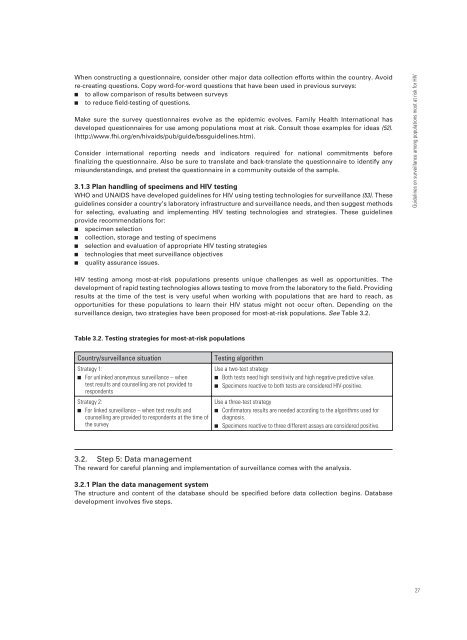Guidelines on surveillance among populations most at risk for HIV
Guidelines on surveillance among populations most at risk for HIV
Guidelines on surveillance among populations most at risk for HIV
- No tags were found...
Create successful ePaper yourself
Turn your PDF publications into a flip-book with our unique Google optimized e-Paper software.
When c<strong>on</strong>structing a questi<strong>on</strong>naire, c<strong>on</strong>sider other major d<strong>at</strong>a collecti<strong>on</strong> ef<strong>for</strong>ts within the country. Avoidre-cre<strong>at</strong>ing questi<strong>on</strong>s. Copy word-<strong>for</strong>-word questi<strong>on</strong>s th<strong>at</strong> have been used in previous surveys: to allow comparis<strong>on</strong> of results between surveys to reduce field-testing of questi<strong>on</strong>s.Make sure the survey questi<strong>on</strong>naires evolve as the epidemic evolves. Family Health Intern<strong>at</strong>i<strong>on</strong>al hasdeveloped questi<strong>on</strong>naires <strong>for</strong> use am<strong>on</strong>g popul<strong>at</strong>i<strong>on</strong>s <strong>most</strong> <strong>at</strong> <strong>risk</strong>. C<strong>on</strong>sult those examples <strong>for</strong> ideas (52).(http://www.fhi.org/en/hivaids/pub/guide/bssguidelines.htm).C<strong>on</strong>sider intern<strong>at</strong>i<strong>on</strong>al reporting needs and indic<strong>at</strong>ors required <strong>for</strong> n<strong>at</strong>i<strong>on</strong>al commitments be<strong>for</strong>efinalizing the questi<strong>on</strong>naire. Also be sure to transl<strong>at</strong>e and back-transl<strong>at</strong>e the questi<strong>on</strong>naire to identify anymisunderstandings, and pretest the questi<strong>on</strong>naire in a community outside of the sample.3.1.3 Plan handling of specimens and <strong>HIV</strong> testingWHO and UNAIDS have developed guidelines <strong>for</strong> <strong>HIV</strong> using testing technologies <strong>for</strong> <strong>surveillance</strong> (53). Theseguidelines c<strong>on</strong>sider a country’s labor<strong>at</strong>ory infrastructure and <strong>surveillance</strong> needs, and then suggest methods<strong>for</strong> selecting, evalu<strong>at</strong>ing and implementing <strong>HIV</strong> testing technologies and str<strong>at</strong>egies. These guidelinesprovide recommend<strong>at</strong>i<strong>on</strong>s <strong>for</strong>: specimen selecti<strong>on</strong> collecti<strong>on</strong>, storage and testing of specimens selecti<strong>on</strong> and evalu<strong>at</strong>i<strong>on</strong> of appropri<strong>at</strong>e <strong>HIV</strong> testing str<strong>at</strong>egies technologies th<strong>at</strong> meet <strong>surveillance</strong> objectives quality assurance issues.<str<strong>on</strong>g>Guidelines</str<strong>on</strong>g> <strong>on</strong> <strong>surveillance</strong> am<strong>on</strong>g popul<strong>at</strong>i<strong>on</strong>s <strong>most</strong> <strong>at</strong> <strong>risk</strong> <strong>for</strong> <strong>HIV</strong><strong>HIV</strong> testing am<strong>on</strong>g <strong>most</strong>-<strong>at</strong>-<strong>risk</strong> popul<strong>at</strong>i<strong>on</strong>s presents unique challenges as well as opportunities. Thedevelopment of rapid testing technologies allows testing to move from the labor<strong>at</strong>ory to the field. Providingresults <strong>at</strong> the time of the test is very useful when working with popul<strong>at</strong>i<strong>on</strong>s th<strong>at</strong> are hard to reach, asopportunities <strong>for</strong> these popul<strong>at</strong>i<strong>on</strong>s to learn their <strong>HIV</strong> st<strong>at</strong>us might not occur often. Depending <strong>on</strong> the<strong>surveillance</strong> design, two str<strong>at</strong>egies have been proposed <strong>for</strong> <strong>most</strong>-<strong>at</strong>-<strong>risk</strong> popul<strong>at</strong>i<strong>on</strong>s. See Table 3.2.Table 3.2. Testing str<strong>at</strong>egies <strong>for</strong> <strong>most</strong>-<strong>at</strong>-<strong>risk</strong> popul<strong>at</strong>i<strong>on</strong>sCountry/<strong>surveillance</strong> situ<strong>at</strong>i<strong>on</strong>Str<strong>at</strong>egy 1: For unlinked an<strong>on</strong>ymous <strong>surveillance</strong> – whentest results and counselling are not provided toresp<strong>on</strong>dentsStr<strong>at</strong>egy 2: For linked <strong>surveillance</strong> – when test results andcounselling are provided to resp<strong>on</strong>dents <strong>at</strong> the time ofthe surveyTesting algorithmUse a two-test str<strong>at</strong>egy Both tests need high sensitivity and high neg<strong>at</strong>ive predictive value. Specimens reactive to both tests are c<strong>on</strong>sidered <strong>HIV</strong>-positive.Use a three-test str<strong>at</strong>egy C<strong>on</strong>fi rm<strong>at</strong>ory results are needed according to the algorithms used <strong>for</strong>diagnosis. Specimens reactive to three different assays are c<strong>on</strong>sidered positive.3.2. Step 5: D<strong>at</strong>a managementThe reward <strong>for</strong> careful planning and implement<strong>at</strong>i<strong>on</strong> of <strong>surveillance</strong> comes with the analysis.3.2.1 Plan the d<strong>at</strong>a management systemThe structure and c<strong>on</strong>tent of the d<strong>at</strong>abase should be specified be<strong>for</strong>e d<strong>at</strong>a collecti<strong>on</strong> begins. D<strong>at</strong>abasedevelopment involves five steps.27















